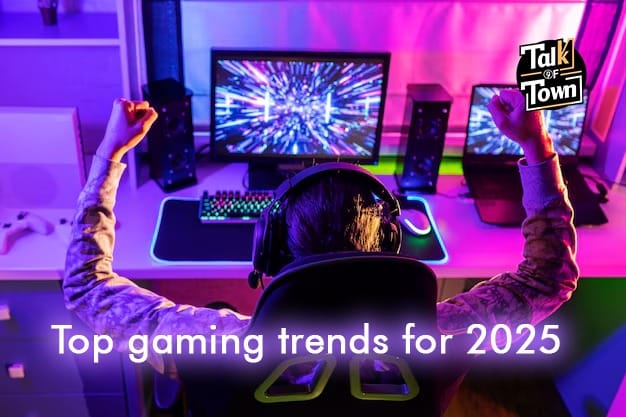- February 10, 2025
Top Gaming Trends for 2025: What Gamers Need to Know

Introduction
The gaming industry is evolving at an unprecedented pace, with new technologies and trends reshaping how we play and experience games. As we look ahead to 2025, several exciting developments are set to revolutionize the gaming landscape. Whether you’re a casual gamer or a hardcore enthusiast, understanding these trends will help you stay ahead of the curve. In this blog, we’ll explore the top gaming trends for 2025 that are set to dominate the industry.
Why Are Gaming Trends Important?
Before diving into the trends, let’s understand why they matter:
- Enhanced Gaming Experience: New technologies make games more immersive and engaging.
- Career Opportunities: Understanding trends can help gamers and developers align with industry demands.
- Stay Competitive: Gamers can leverage new tools and platforms to improve their skills.
- Future-Proofing: Early adoption of trends ensures you’re not left behind.
Top Gaming Trends for 2025
1. AI-Powered Games
Artificial Intelligence (AI) is transforming game development and gameplay.
- What to Expect:
- Smarter NPCs (Non-Player Characters) with realistic behavior.
- Procedural content generation for unique gaming experiences.
- AI-driven personalization to adapt games to individual players.
- Examples: AI Dungeon Masters in RPGs, dynamic storylines.
Transition: AI is not just a tool for developers; it’s becoming a core part of the gaming experience.
2. Cloud Gaming Dominance
Cloud gaming is set to become mainstream by 2025.
- What to Expect:
- High-quality gaming on any device without the need for expensive hardware.
- Subscription-based models like Xbox Cloud Gaming and NVIDIA GeForce NOW.
- Reduced latency and improved streaming quality.
- Examples: Play AAA games on your smartphone or tablet.
Transition: Cloud gaming is breaking barriers, making gaming more accessible than ever.
3. Virtual Reality (VR) and Augmented Reality (AR)
VR and AR technologies are becoming more immersive and affordable.
- What to Expect:
- Lightweight, wireless VR headsets with better graphics.
- AR games that blend the virtual and real worlds seamlessly.
- New genres of games designed specifically for VR/AR.
- Examples: Meta Quest 3, Apple Vision Pro integration.
Transition: VR and AR are no longer niche; they’re becoming integral to the gaming experience.
4. Blockchain and Play-to-Earn Games
Blockchain technology is revolutionizing in-game economies.
- What to Expect:
- True ownership of in-game assets through NFTs.
- Play-to-earn models where players can monetize their skills.
- Decentralized gaming platforms.
- Examples: Axie Infinity, The Sandbox.
Transition: Blockchain is empowering gamers to earn while they play.
5. Cross-Platform Gaming
Cross-platform play is becoming the norm.
- What to Expect:
- Seamless gameplay across consoles, PCs, and mobile devices.
- Unified accounts and progress tracking.
- More multiplayer games supporting cross-platform play.
- Examples: Fortnite, Call of Duty: Warzone.
Transition: Cross-platform gaming is breaking down barriers between devices.
6. Hyper-Realistic Graphics
Advancements in graphics technology are making games look more realistic than ever.
- What to Expect:
- Ray tracing for lifelike lighting and shadows.
- 8K resolution gaming for ultra-sharp visuals.
- Real-time rendering for cinematic experiences.
- Examples: Unreal Engine 5 games, next-gen consoles.
Transition: Hyper-realistic graphics are blurring the line between games and reality.
7. Esports and Competitive Gaming
Esports is growing into a billion-dollar industry.
- What to Expect:
- More tournaments with massive prize pools.
- Increased viewership and sponsorships.
- Integration of AI and analytics for player performance.
- Examples: League of Legends Worlds, Dota 2 International.
Transition: Esports is no longer just a trend; it’s a global phenomenon.
8. Social and Metaverse Gaming
The metaverse is creating new social gaming experiences.
- What to Expect:
- Virtual worlds where players can socialize, trade, and play.
- Integration of gaming with social media platforms.
- User-generated content and economies.
- Examples: Roblox, Fortnite Creative Mode.
Transition: The metaverse is redefining how we interact with games and each other.
9. Sustainability in Gaming
The gaming industry is becoming more eco-conscious.
- What to Expect:
- Energy-efficient gaming hardware.
- Carbon-neutral game development practices.
- Games promoting environmental awareness.
- Examples: Eco-friendly consoles, green gaming initiatives.
Transition: Sustainability is becoming a key focus for developers and gamers alike.
10. Personalized Gaming Experiences
Games are becoming more tailored to individual players.
- What to Expect:
- Adaptive difficulty levels based on player skill.
- Customizable storylines and characters.
- AI-driven recommendations for games and content.
- Examples: Personalized quests in RPGs, dynamic game worlds.
Transition: Personalization is making gaming more engaging and inclusive.
Conclusion
The gaming industry is on the brink of a major transformation, with exciting trends set to redefine how we play and experience games in 2025. From AI-powered games and cloud gaming to VR innovations and blockchain integration, the future of gaming is bright and full of possibilities. Whether you’re a gamer, developer, or industry enthusiast, staying informed about these trends will help you navigate the evolving landscape and make the most of what’s to come.
FAQs
Q1. What is the future of mobile gaming?
Mobile gaming will continue to grow, with cloud gaming and 5G enabling high-quality games on smartphones.
Q2. How will AI impact game development?
AI will streamline development, create smarter NPCs, and offer personalized gaming experiences.
Q3. Are VR headsets becoming more affordable?
Yes, advancements in technology are making VR headsets more accessible and affordable.

